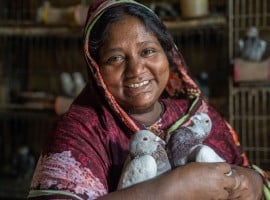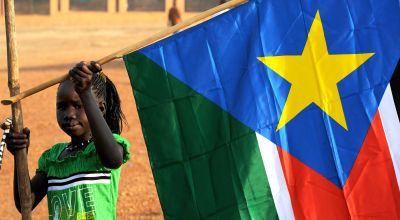
Read our 2024 annual report

Knowledge Hub
A combination of conflict and climate change has left South Sudan consistently ranking among the world’s hungriest countries. The world’s youngest country has faced food security crises throughout its 10 years of independence.
After a famine in some regions in 2017, parts of the country is now once again facing similar conditions, due in large part to renewed violence, the worst flooding in 100 years, and the impacts of COVID-19. Here’s what to know about hunger in South Sudan in 2023 — and what can be done to end it.
Hunger in South Sudan by the numbers:
- 7.2 million people in food crisis
- 2.4 million people at risk of famine if they don’t receive aid
- 1.4 million children suffering from acute malnutrition
- 483,000 malnourished pregnant or lactating women
- Credible risk of Famine (IPC Phase 5) in northern Jonglei and parts of Upper Nile
- Emergency (IPC Phase 4) levels of acute food insecurity in 2023
Conflict and hunger create a vicious cycle for South Sudanese
For South Sudan, one of the biggest causes and maintainers of hunger is conflict. Even before its peaceful secession from Sudan, South Sudan was plagued by intermittent violence and insecurity. The country’s most recent famine (in 2017) was fuelled by conflict. In light of renewed fighting, parts of the country are once again threatened with the same possibility.
Hunger is both a cause and consequence of South Sudan's crisis at large. Communal violence reduces agricultural productivity and harvests. The lack of food that results from this is correlated with an increase in poaching and cattle theft in affected areas. This, in turn, leads to added tension and conflict. This violence impacts the work of humanitarian organisations (including Concern), and can often interrupt work for weeks at a time. It’s not uncommon for UN agencies and other NGOs to call for an immediate end to violence in areas where civilians are otherwise unable to be reached with food distributions or even adequate food security assessments.
Displacement brings additional challenges
Over 2 million South Sudanese people have fled into neighbouring countries, with an additional 1.74 million people displaced inside the country due to conflict. When fighting started, civilians found refuge at existing United Nations bases, which have now become sites for internally displaced persons (IDPs). However, protection doesn’t mean “provided for.” As 32-year-old mother Khadra* explains at one camp in Juba: “When we were at home, we had food. We worked. Life was good; you were free. So no problem.”
Khadra was forced to leave her village in 2013 in search of food, water, and — above all — safety. But being in an IDP camp comes with “a lot of challenges… it is like a prison. Your children are malnourished; you are just waiting for humanitarian aid to come. It is very difficult.”
Luka Mathiang, Concern's Nutrition Project Officer in Juba, concurs that life in an IDP camp is not easy. While many come hoping for their basic needs to be met while in displacement, those aren't guaranteed. Originally built to provide shelter and protection for 72 hours, and still being used years later, it’s not surprising that the conditions are dire. “There is no food, no water. You do not know if you will survive or if you will die along the way,” Luka explains.
“Staying here is very hard, but the only thing that is okay is that you don’t hear bullets,” says another resident, Dukan*.
When we were at home, we had food. We worked. Life was good; you were free. So no problem.
Options are limited due to funding cuts and donor fatigue
Traditionally, the World Food Programme has made food distributions in IDP camps, including beans, lentils, and sorghum. But it’s not enough to get proper nourishment, despite no way of getting additional food.
This is especially worrisome in 2023, as humanitarian funding continues to fall short in South Sudan. In October 2021, the World Food Programme suspended food assistance for more than 100,000 displaced people due to budget restrictions. A few months earlier, foreign assistance from the United Kingdom to South Sudan was cut due to austerity measures. “Without Concern in this area, children can really suffer a lot,” says Idil*, a 28-year-old mother-of-three living in a camp.
Nearly 87% of South Sudan depends on agriculture and livestock
As mentioned above, part of South Sudan’s conflict is due to a lack of resources. And while many South Sudanese don’t rely on food aid to meet their daily needs, eating enough quality food is still a challenge.
With nearly 87% of the country dependent on agriculture, livestock and forestry, grazing land and water are often scarce commodities. One report conducted by Concern and local research organisation the SUDD Institute showed that conflict in South Sudan often coincides with a recent flood or drought, a time when farmers and cattle herders are forced to temporarily or permanently relocate and share resources. These resources quickly become points of tension.
Policies and regulations around land are limited, leaving land disputes to make up 80 to 90% of civil cases in the South Sudanese courts. These cases and disputes also limit what farmers are able to produce — thereby creating additional food and income shortages.
Gender inequality is a major barrier to ending hunger
Some local customs serve as major barriers to gender equality in South Sudan. Traditionally, women have no decision-making powers within the household, aren’t allowed to access loans, and also lack access to water points and livestock. They also have no land ownership rights. Land is predominantly owned by men, and inheritance practices favour male family members as well.
Even when women can access land, the fact that they do not own it disincentivises their investing time, money, and resources into sustainable farming practices that would offset the challenges brought on by climate change.
South Sudan is also one of the worst places to be an expecting or new mother, as malnutrition among pregnant and lactating women is alarmingly common — especially in displacement camps. Providing for children is also a challenge. “The biggest challenge is all about the needs of the children. Now they are getting greens, but they need more substance. They sometimes need rice and millet. We also need cowpeas and beans,” one mother explains.

With few financial safety nets in place, cash and hunger exist in a vicious cycle
Most of the grain produced in South Sudan goes through local markets, where families purchase approximately a third of whatever they produce. Recent research has shown a correlation between depending on markets to eat and hunger rates. Many who depend on markets to earn income for food or to barter their harvests don’t have cash on hand. This is most apparent in the areas of South Sudan hit hardest by conflict.
This is one aspect of the financial crisis in South Sudan, whose main export is crude oil (the price for which has dropped), and which has suffered further economic setbacks due to the COVID-19 pandemic. With an estimated 82% of South Sudanese living below the poverty line, this means that the majority of the country lacks the financial safety nets they need to weather a financial setback or a poor harvest and still put food on the table.
Hunger in South Sudan: What the government is doing
The Government of South Sudan is working to address food insecurity through climate change measures, investments in agriculture, and food relief to those in emergency situations. Their 2019-20 national budget allocated $2.3 million to the Ministry of Agriculture and Food Security, which is higher than most other sectors working to address similar needs.
The government has also developed and adopted several climate change and environmental protection policies with the aim of improving food security for the country, including the Paris Climate Agreement, the National Environment Policy 2015-2025, Environment Policy Framework, Environment Bill, UN Convention on Biological Diversity (CBD), National Biodiversity Strategy and Action Plan (NBSAP), Convention to Combat Desertification (CCD), and the National Adaptation Plan of Action (NAPA).
Hunger in South Sudan: What Concern is doing
Concern has been in South Sudan since the beginning. Our work is a combination of emergency response and resilience building, with a large emphasis on food security. We lead one of the nutrition programmes that run in the IDP camps in Juba, treating malnourished children from six months to five years, and offering support to pregnant and lactating women. Here are some other highlights from our most recent annual report:
- Lifesaving emergency nutrition and health services comprising nutrition, health, shelter, livelihoods, and WASH programmes reaching nearly 629,000 people — mainly women and children.
- Water, sanitation, and hygiene programmes that reached over 184,000 people.
- Food security and resilience improved for 24,000 people in Aweil North and Aweil South counties.
- Nearly 4,000 people met immediate- and medium-term food needs through a six-month cash and food distribution cycle.
- In five countries including South Sudan, we launched ERNE — Enhanced Responses to Nutrition Emergencies — to tackle malnutrition in children under the age of five while simultaneously strengthening local health systems. In our first year, we reached over 342,000 people across all five countries.
Find out more about Concern's work in South Sudan





